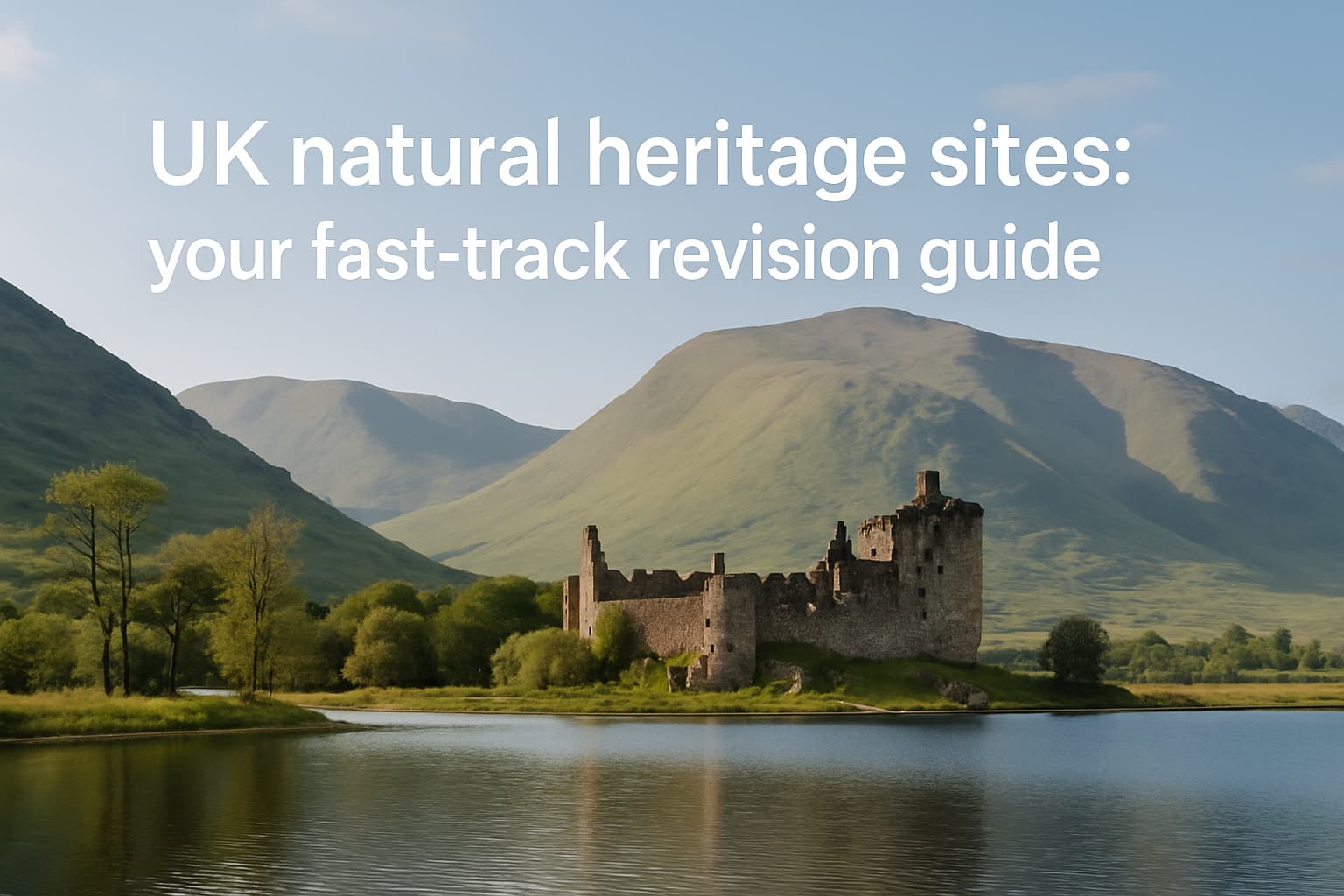UK natural heritage sites: your fast-track revision guide

Short on time? This fast-track revision guide gives you exactly what you need to recognise UK UNESCO natural heritage sites in the Life in the UK Test — and avoid the classic traps under pressure.
We will quickly define natural vs cultural sites, drill the three natural sites the handbook emphasises, show common question formats, and give mnemonics, a mini quiz, and a smarter study plan using the Life in the UK Test App.
Why UNESCO sites matter for the Life in the UK Test
The official handbook includes UNESCO World Heritage Sites because they are nationally significant. In the exam, you are typically tested on the difference between natural and cultural heritage sites and on locations or key features.
Good news: the handbook highlights only three natural heritage sites you must know. Master those first to protect easy marks, then learn the most-paired cultural sites to avoid mix-ups.
Natural vs cultural in one minute
Quick definition
Natural heritage sites: Inscribed for outstanding natural value such as geology, landforms, ecosystems or biodiversity.
Cultural heritage sites: Inscribed for outstanding human-made value such as monuments, historic cities, archaeology or architecture.
England check: There is one natural World Heritage Site in England — the Dorset and East Devon Coast (the Jurassic Coast) — recognised for its geological value. This comes directly from official guidance on World Heritage Sites in England.
Category | What to look for | Typical UK example |
|---|---|---|
Natural | Landforms, rocks, fossils, wildlife, remote coastlines | Giant’s Causeway; Jurassic Coast; St Kilda |
Cultural | Prehistoric circles, Roman or Norman remains, cathedrals, historic cities | Stonehenge and Avebury; Hadrian’s Wall; Tower of London |
How questions usually appear (and traps)
Which of the following is a natural site? Options may mix in cultural sites. Watch for geological clues like basalt columns or fossils.
Match the site to the nation/region: England, Scotland, Wales, or Northern Ireland; or specific counties like Dorset and East Devon.
Trap distractors:
Date/era bait: If a date or era (Neolithic, Roman, Norman) is mentioned, it’s almost certainly cultural, not natural.
Place-name mix-ups: The Jurassic Coast is in England, not Scotland or Northern Ireland.
Designation confusion: National Parks or AONBs are not automatically UNESCO sites.
The UK natural heritage sites you must know
These three appear in the handbook and are the most testable. Memorise the bolded facts and a one-line mnemonic for each.
Giant’s Causeway and Causeway Coast (Northern Ireland)
Where: County Antrim, Northern Ireland.
What: Around 40,000 interlocking basalt hexagonal columns formed by ancient volcanic activity.
Why UNESCO: Exceptional example of volcanic geology and coastal landforms.
Exam cues: “Basalt”, “hexagons”, “Causeway”. If you see dates/armies/cathedrals, it’s not this site.
Mnemonic: “NI = Natural Hexes” — Northern Ireland, natural site, hexagon columns.
Dorset and East Devon Coast — the Jurassic Coast (England)
Where: South coast of England, spanning Dorset and East Devon.
What: A continuous record of Earth history with fossils from the Triassic, Jurassic and Cretaceous periods.
Why UNESCO: Global geological value; textbook coastal erosion and fossil discovery coast.
Exam cues: “Fossils”, “Dorset”, “East Devon”. It’s the only natural World Heritage Site in England.
Mnemonic: “Jurassic = Jurassic fossils in Jurassic counties” — think fossils across Dorset and East Devon.
St Kilda (Scotland)
Where: Remote archipelago in the Outer Hebrides, Scotland.
What: Dramatic sea cliffs and stacks; world-class seabird colonies (gannets, puffins).
Why UNESCO: Inscribed for natural values (ecology, landscapes) and recognised for significant cultural remains of a former community.
Exam cues: “Seabirds”, “Hebrides”, “remote archipelago”. Mixed natural/cultural story, but core identity is remote and ecological.
Mnemonic: “St Kilda’s sky = seabirds in Scotland”.
Update you may see in the news (not essential for the current test): Scotland’s Flow Country peatlands were recently recognised by UNESCO as a World Heritage Site, noted for storing around 400 million tonnes of carbon and supporting rare wetland species. The Life in the UK Test is based on the handbook edition you study, so focus on the three sites above for exam day.
Cultural heritage sites that appear alongside in questions
These cultural sites often sit in the same multiple-choice lists. Use the era and location anchors to avoid clicking a natural site by mistake.
Stonehenge and Avebury (Wiltshire)
Era: Neolithic and Bronze Age.
Purpose: Ritual/ceremonial, astronomical alignments.
Where: Wiltshire, southwest England.
Hadrian’s Wall — Frontiers of the Roman Empire
Era: Roman Britain (2nd century AD).
What: Defensive frontier across northern England.
Clue: If “Roman” appears, it’s cultural, not natural.
The Tower of London
Origins: Norman (William the Conqueror).
Known for: The Crown Jewels.
Where: By the River Thames in central London.
The City of Bath
Heritage: Roman baths and Georgian architecture.
Where: Somerset.
Canterbury Cathedral, St Augustine’s Abbey & St Martin’s
Theme: Early Christianity in England; seat of the Archbishop of Canterbury.
Where: Kent.
Durham Castle and Cathedral
Style: Norman architecture.
Where: City of Durham on the River Wear.
Memory hooks and mnemonics that stick
Natural sites: three-image chain
See hexagons locking together (Giant’s Causeway).
Those hexagons roll into a beach of fossils (Jurassic Coast).
Fossils lift into a sky full of seabirds over remote sea cliffs (St Kilda).
Repeat the story in 5 seconds and you will instantly recall which is which under time pressure.
Cultural sites: era anchors
Neolithic = Stonehenge and Avebury.
Roman = Hadrian’s Wall.
Norman = Tower of London; Norman style at Durham Cathedral.
Georgian = City of Bath crescents and terraces.
Quick-fire mini quiz (with explanations)
Identify the natural site
Which is a natural World Heritage Site: A) Tower of London B) Giant’s Causeway C) Canterbury Cathedral D) Durham Cathedral
Answer: B. Basalt columns = natural geology.Which site is famous for fossils: A) Stonehenge B) Hadrian’s Wall C) Jurassic Coast D) Tower of London
Answer: C. Fossils scream “natural”.
Match site to nation/region
St Kilda is in: A) Wales B) Scotland C) England D) Northern Ireland
Answer: B. Outer Hebrides, Scotland.Giant’s Causeway is in: A) Scotland B) Northern Ireland C) England D) Wales
Answer: B. County Antrim.
True/false trap busters
True or false: The Jurassic Coast is the only natural World Heritage Site in England.
Answer: True. That’s explicitly noted in official guidance.True or false: Dates like “Neolithic” usually indicate a natural site.
Answer: False. Dates/eras are cultural clues.
Revise smarter with the Life in the UK Test App
If you feel overwhelmed by names, dates, and places, the Life in the UK Test App turns the handbook into a guided path — so you don’t run out of time or pay for retests.
Problem: Too much content — The app’s Brit-Bear assistant prioritises weak topics (like UNESCO sites) for you.
Problem: Not sure you’re ready — Track your Readiness Score to know when to book the test.
Problem: Need realistic practice — 650+ questions with explanations and Hard Mode mocks that feel like the real exam.
Problem: Studying on the go — Offline access on iOS and Android.
See proven strategies to structure your study and try a free practice test to benchmark your starting point.

Brit-Bear guidance + Readiness Score
Brit-Bear adapts your plan to target weak areas like natural vs cultural sites, while the Readiness Score shows if your accuracy and speed are exam-ready.
Hard Mode mocks and 650+ question bank
Build recognition with timed, exam-style items featuring UNESCO questions and full explanations. Review errors until your Readiness Score turns green.
Study anywhere: iOS and Android
Download once, then study offline on your commute or lunch break.
Wrap-up and next steps
Remember the three natural heritage sites in the handbook: Giant’s Causeway (basalt hexagons, Northern Ireland), Jurassic Coast (fossils, Dorset and East Devon, only natural site in England), and St Kilda (seabirds, remote Hebrides, Scotland). Pair them with the most common cultural companions — Stonehenge and Avebury, Hadrian’s Wall, Tower of London, Bath, Canterbury, Durham — and you will avoid 90% of traps.
Next: take a free practice test, then let Brit-Bear focus your next session. For broader prep, read the most challenging topics and common mistakes to avoid.
Ready to pass on your first attempt? Install the app now: App Store | Google Play.
References and quick facts
Official guidance confirms the Jurassic Coast is the only natural World Heritage Site in England. See the policy overview and related details on protection and management of World Heritage Sites in England.
Recent news note: The Flow Country peatlands in Scotland were recognised by UNESCO for their global environmental importance, including storing ~400 million tonnes of carbon. Useful context, but the test follows the handbook you study.
Designations like AONB have different criteria from UNESCO, focusing on natural beauty, tranquillity and heritage features. Do not confuse these with World Heritage Sites in exam questions.
FAQ
Which UK natural heritage sites should I memorise for the test?
Giant’s Causeway (Northern Ireland), Dorset and East Devon Coast or Jurassic Coast (England), and St Kilda (Scotland).
How do I quickly tell natural vs cultural sites?
Look for geology, fossils, wildlife for natural; look for eras, rulers, cathedrals, forts for cultural.
Is the Jurassic Coast the only natural World Heritage Site in England?
Yes. That’s an official point often tested.
Do recent UNESCO additions affect my exam?
The test follows the handbook edition you study. Prioritise the three natural sites listed there.
What is the fastest way to practice these topics?
Use timed mocks and targeted reviews in the Life in the UK Test App, focusing on UNESCO items until your Readiness Score is green.